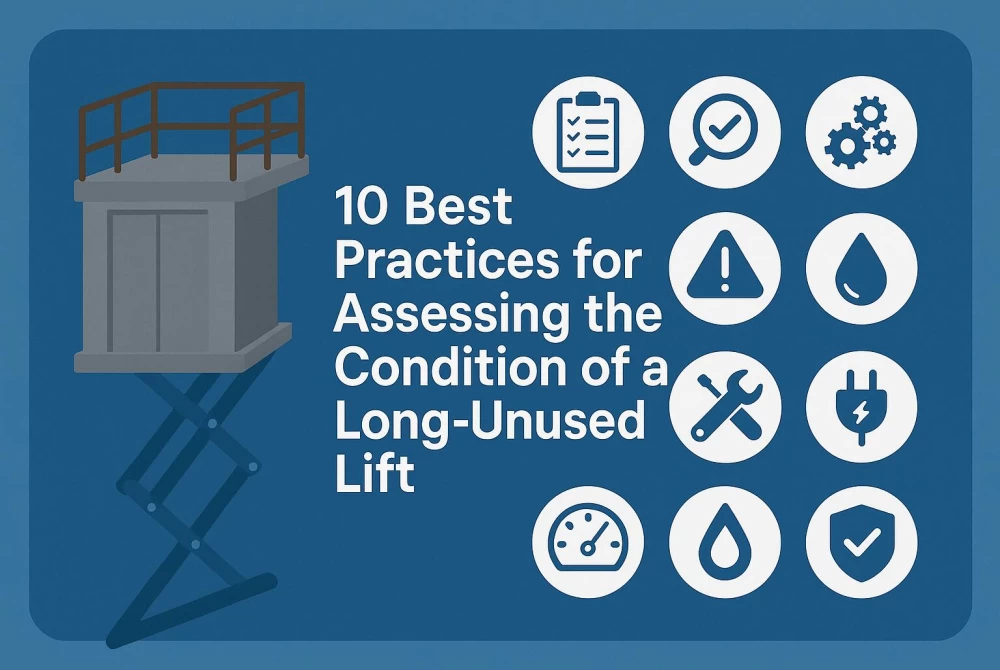
- Published 26 May, 2025
10 Best Practices for Assessing the Condition of a Long-Unused Lift
When a lift is unused for a long time, problems may occur. Dust, rust, or wear might affect its safe operation. Before restarting it, a proper check must be done. Safety risks can be avoided through simple steps. Old lifts should not be used without assessment. Important parts might get damaged over time. Proper care must be taken before using them.
By following these best practices listed by best Lift manufacturers in Delhi, safety can be ensured.
A Visual Inspection Should Be Done Before Any Operation
A full visual check must be done before use. All lift parts should be looked at with care. Rust or cracks may be found on metal surfaces. Warning signs must be noticed during this inspection step. Cables and panels should be checked for visible damage. Dust and dirt must be removed from key areas. Any broken parts must be reported to a technician.
The Lift's Power Supply Must Be Tested Safely
The main power source should be checked before turning on. Old wiring might have been damaged over the years. Loose connections must be found and fixed by experts. Burnt smells should be noticed during the power check. All fuses and breakers must be tested for faults. Power flow should be smooth and safely maintained always. Safety tools must be used during the testing process.
All Buttons and Control Panels Should Be Tested Properly
All lift buttons must be pressed to check their response. Broken or stuck buttons should be reported without delay. The control panel must be checked for lights and sounds. Faulty signals can be noticed during simple button tests. No delay should be found when buttons are pressed. The display screen should be tested for correct readings. Emergency buttons must also be tested for quick response.
The Shaft and Pit Must Be Cleaned and Checked
The lift shaft must be inspected for dust and debris. Water or oil leaks should be found and reported quickly. The pit area must be cleaned before any operation begins. Trash or rust must be removed from all key spots. Signs of damage should be noticed during this check. Any pests or insects must be cleared from the area. Metal parts should be checked for rust or cracks.
Lift Doors Should Be Tested for Smooth, Safe Movement
The doors should be opened and closed several times slowly. Jerky or stuck movements must be noticed and reported quickly. Sensors must be checked for proper response during door tests. Any delay in door action should be taken seriously. Dirt or rust should be cleaned from door tracks properly. The door motor must be tested for smooth working. Manual door release must also be checked by experts.
Brake Systems Must Be Checked by a Trained Technician
The brake system must be tested before the lift runs. Brake pads should be checked for wear and tear carefully. Unusual sounds must be noticed during brake testing steps. The lift must not move when brakes are applied. Emergency brakes should be tested under expert supervision only. Loose brake parts must be repaired or replaced as needed. All brake functions must be tested in every condition.
Cables and Pulleys Should Be Examined for Signs of Wear
All cables must be checked for cuts, rust, or fraying. Pulleys should be examined for cracks or loose fittings carefully. Tension in the cables must be tested by professionals. Old or weak cables must be replaced without any delay. Sharp edges should be checked around pulley systems closely. Signs of wear must be taken as a warning. The movement of cables should be smooth and noise-free.
Lubrication Levels Must Be Checked and Updated as Needed
All moving parts should be inspected for proper lubrication first. Dry parts must be lubricated to reduce friction and wear. Old grease or oil should be cleaned before fresh oil is applied. Bearings and joints must be checked for smooth movement carefully. Lubricants approved for lifts should always be used by technicians. Excess oil must be wiped away to avoid dirt buildup. Regular lubrication helps prevent mechanical failures and noise.
Emergency Systems Should Be Tested for Proper Functioning
All emergency alarms must be checked to ensure loud sounds. Backup power systems should be tested during a power failure. The emergency lighting must be verified for brightness and duration. Intercoms must be tested for clear communication inside the lift. Fire safety devices should be inspected and maintained regularly. Emergency stop buttons must be pressed to check quick response. Faulty emergency systems must be repaired before the lift is used.
A Certified Lift Technician Must Perform the Final Assessment
The final inspection should always be done by a professionals like automobile elevator manufacturers in Delhi. All test results must be reviewed by the certified technician. Any problems found must be reported and fixed immediately. Safety standards must be followed strictly during the final check. Only a trained expert can approve the lift for use. Maintenance records should be updated after the full assessment. The lift must be certified safe before it is restarted.
